Business Decision Making: Data Analysis Report for UKCBC
VerifiedAdded on 2020/01/07
|20
|4600
|153
Report
AI Summary
This report provides a comprehensive analysis of business decision-making, focusing on a data-driven approach. It begins with an introduction to the importance of decision-making in business, followed by a detailed plan for collecting student data across multiple campuses. The report outlines the survey methodology, including sampling frames and the design of a questionnaire used to gather student feedback. The second task involves data summarization, presenting survey results, and drawing conclusions based on measures of dispersion, quartiles, percentiles, and correlation coefficients. The report also includes data visualization through graphs and trend lines. Task three covers the use of information processing tools, project planning with a critical path analysis, and the application of financial tools for decision-making. The report concludes with a summary of findings and recommendations, aiming to assist UKCBC in its review process and improve its operational efficiency. This project utilized primary and secondary research methodologies to provide a solid foundation for making informed decisions, which is then presented to the Quality Assurance Agency (QAA).

BUSINESS DECISION
MAKING
MAKING
Paraphrase This Document
Need a fresh take? Get an instant paraphrase of this document with our AI Paraphraser
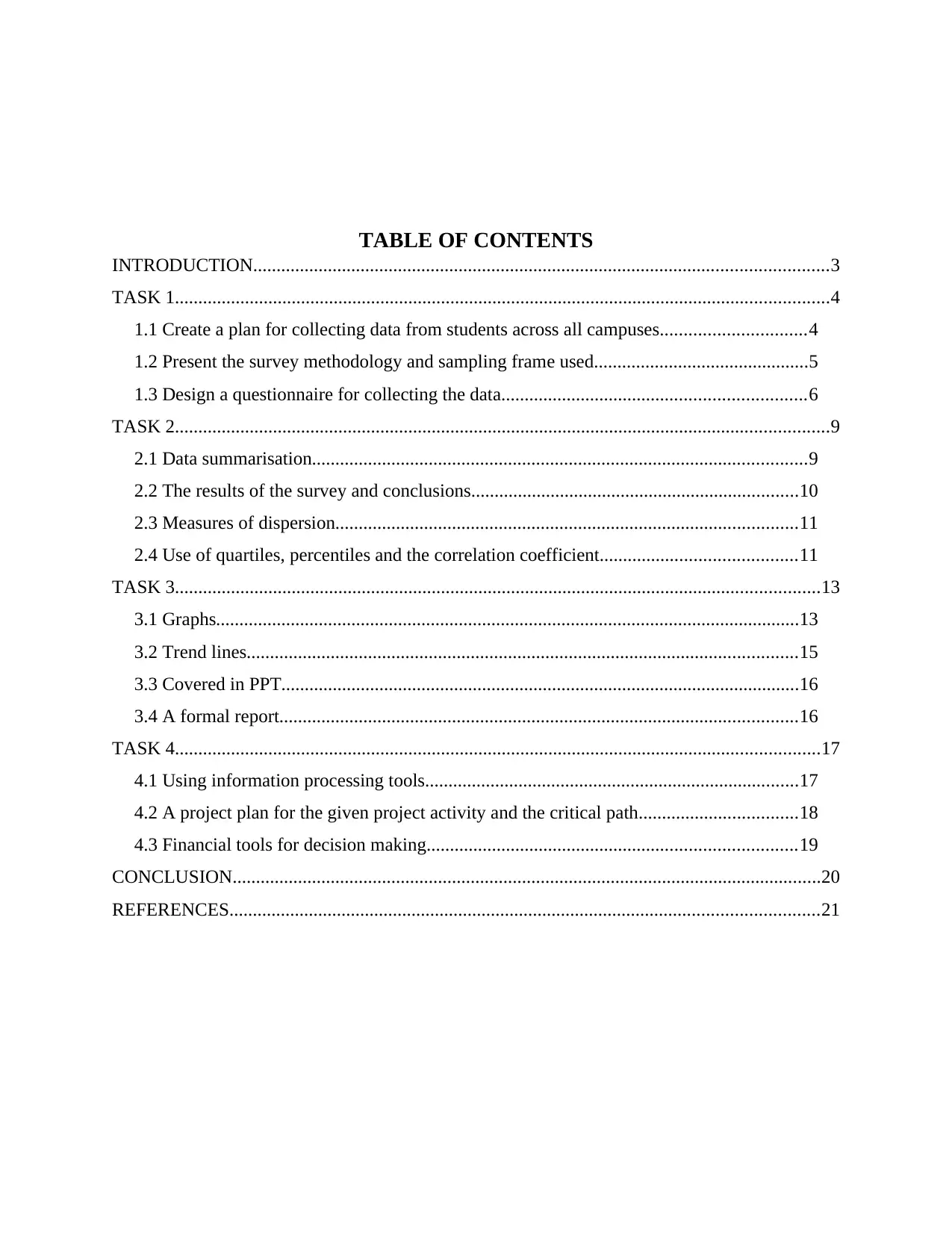
TABLE OF CONTENTS
INTRODUCTION...........................................................................................................................3
TASK 1............................................................................................................................................4
1.1 Create a plan for collecting data from students across all campuses...............................4
1.2 Present the survey methodology and sampling frame used..............................................5
1.3 Design a questionnaire for collecting the data.................................................................6
TASK 2............................................................................................................................................9
2.1 Data summarisation..........................................................................................................9
2.2 The results of the survey and conclusions......................................................................10
2.3 Measures of dispersion...................................................................................................11
2.4 Use of quartiles, percentiles and the correlation coefficient..........................................11
TASK 3..........................................................................................................................................13
3.1 Graphs.............................................................................................................................13
3.2 Trend lines......................................................................................................................15
3.3 Covered in PPT...............................................................................................................16
3.4 A formal report...............................................................................................................16
TASK 4..........................................................................................................................................17
4.1 Using information processing tools................................................................................17
4.2 A project plan for the given project activity and the critical path..................................18
4.3 Financial tools for decision making...............................................................................19
CONCLUSION..............................................................................................................................20
REFERENCES..............................................................................................................................21
INTRODUCTION...........................................................................................................................3
TASK 1............................................................................................................................................4
1.1 Create a plan for collecting data from students across all campuses...............................4
1.2 Present the survey methodology and sampling frame used..............................................5
1.3 Design a questionnaire for collecting the data.................................................................6
TASK 2............................................................................................................................................9
2.1 Data summarisation..........................................................................................................9
2.2 The results of the survey and conclusions......................................................................10
2.3 Measures of dispersion...................................................................................................11
2.4 Use of quartiles, percentiles and the correlation coefficient..........................................11
TASK 3..........................................................................................................................................13
3.1 Graphs.............................................................................................................................13
3.2 Trend lines......................................................................................................................15
3.3 Covered in PPT...............................................................................................................16
3.4 A formal report...............................................................................................................16
TASK 4..........................................................................................................................................17
4.1 Using information processing tools................................................................................17
4.2 A project plan for the given project activity and the critical path..................................18
4.3 Financial tools for decision making...............................................................................19
CONCLUSION..............................................................................................................................20
REFERENCES..............................................................................................................................21

⊘ This is a preview!⊘
Do you want full access?
Subscribe today to unlock all pages.

Trusted by 1+ million students worldwide
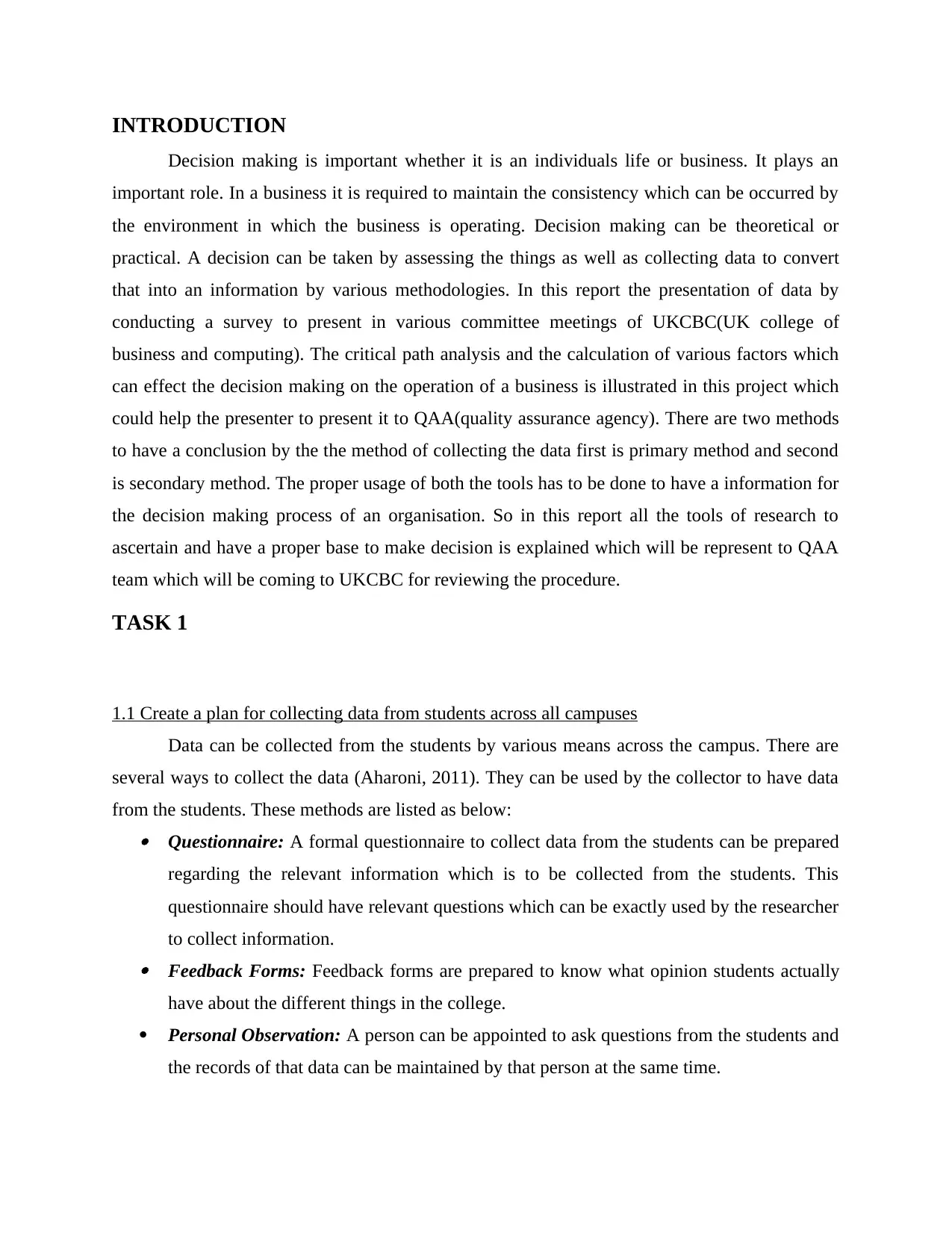
INTRODUCTION
Decision making is important whether it is an individuals life or business. It plays an
important role. In a business it is required to maintain the consistency which can be occurred by
the environment in which the business is operating. Decision making can be theoretical or
practical. A decision can be taken by assessing the things as well as collecting data to convert
that into an information by various methodologies. In this report the presentation of data by
conducting a survey to present in various committee meetings of UKCBC(UK college of
business and computing). The critical path analysis and the calculation of various factors which
can effect the decision making on the operation of a business is illustrated in this project which
could help the presenter to present it to QAA(quality assurance agency). There are two methods
to have a conclusion by the the method of collecting the data first is primary method and second
is secondary method. The proper usage of both the tools has to be done to have a information for
the decision making process of an organisation. So in this report all the tools of research to
ascertain and have a proper base to make decision is explained which will be represent to QAA
team which will be coming to UKCBC for reviewing the procedure.
TASK 1
1.1 Create a plan for collecting data from students across all campuses
Data can be collected from the students by various means across the campus. There are
several ways to collect the data (Aharoni, 2011). They can be used by the collector to have data
from the students. These methods are listed as below: Questionnaire: A formal questionnaire to collect data from the students can be prepared
regarding the relevant information which is to be collected from the students. This
questionnaire should have relevant questions which can be exactly used by the researcher
to collect information. Feedback Forms: Feedback forms are prepared to know what opinion students actually
have about the different things in the college.
Personal Observation: A person can be appointed to ask questions from the students and
the records of that data can be maintained by that person at the same time.
Decision making is important whether it is an individuals life or business. It plays an
important role. In a business it is required to maintain the consistency which can be occurred by
the environment in which the business is operating. Decision making can be theoretical or
practical. A decision can be taken by assessing the things as well as collecting data to convert
that into an information by various methodologies. In this report the presentation of data by
conducting a survey to present in various committee meetings of UKCBC(UK college of
business and computing). The critical path analysis and the calculation of various factors which
can effect the decision making on the operation of a business is illustrated in this project which
could help the presenter to present it to QAA(quality assurance agency). There are two methods
to have a conclusion by the the method of collecting the data first is primary method and second
is secondary method. The proper usage of both the tools has to be done to have a information for
the decision making process of an organisation. So in this report all the tools of research to
ascertain and have a proper base to make decision is explained which will be represent to QAA
team which will be coming to UKCBC for reviewing the procedure.
TASK 1
1.1 Create a plan for collecting data from students across all campuses
Data can be collected from the students by various means across the campus. There are
several ways to collect the data (Aharoni, 2011). They can be used by the collector to have data
from the students. These methods are listed as below: Questionnaire: A formal questionnaire to collect data from the students can be prepared
regarding the relevant information which is to be collected from the students. This
questionnaire should have relevant questions which can be exactly used by the researcher
to collect information. Feedback Forms: Feedback forms are prepared to know what opinion students actually
have about the different things in the college.
Personal Observation: A person can be appointed to ask questions from the students and
the records of that data can be maintained by that person at the same time.
Paraphrase This Document
Need a fresh take? Get an instant paraphrase of this document with our AI Paraphraser
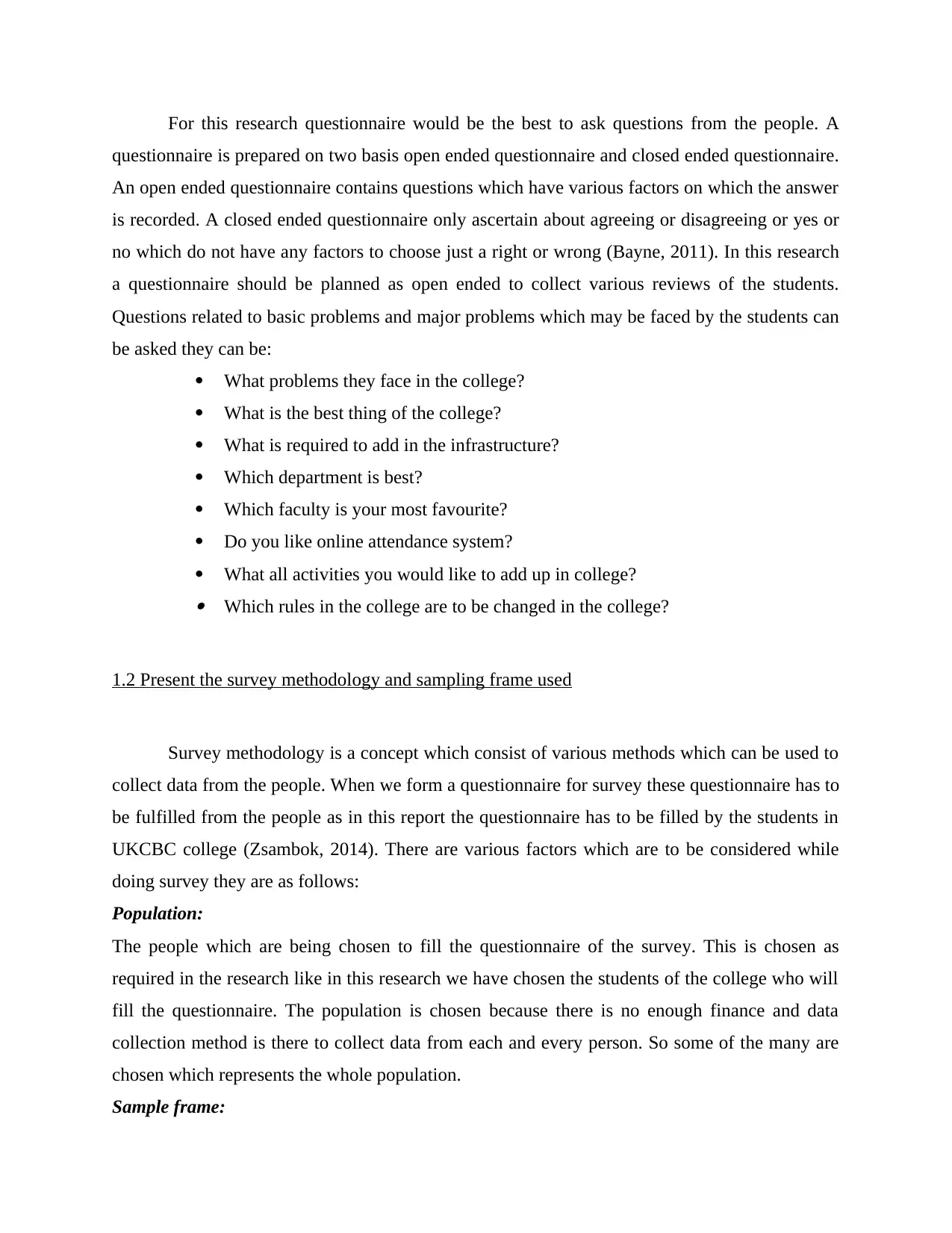
For this research questionnaire would be the best to ask questions from the people. A
questionnaire is prepared on two basis open ended questionnaire and closed ended questionnaire.
An open ended questionnaire contains questions which have various factors on which the answer
is recorded. A closed ended questionnaire only ascertain about agreeing or disagreeing or yes or
no which do not have any factors to choose just a right or wrong (Bayne, 2011). In this research
a questionnaire should be planned as open ended to collect various reviews of the students.
Questions related to basic problems and major problems which may be faced by the students can
be asked they can be:
What problems they face in the college?
What is the best thing of the college?
What is required to add in the infrastructure?
Which department is best?
Which faculty is your most favourite?
Do you like online attendance system?
What all activities you would like to add up in college?
Which rules in the college are to be changed in the college?
1.2 Present the survey methodology and sampling frame used
Survey methodology is a concept which consist of various methods which can be used to
collect data from the people. When we form a questionnaire for survey these questionnaire has to
be fulfilled from the people as in this report the questionnaire has to be filled by the students in
UKCBC college (Zsambok, 2014). There are various factors which are to be considered while
doing survey they are as follows:
Population:
The people which are being chosen to fill the questionnaire of the survey. This is chosen as
required in the research like in this research we have chosen the students of the college who will
fill the questionnaire. The population is chosen because there is no enough finance and data
collection method is there to collect data from each and every person. So some of the many are
chosen which represents the whole population.
Sample frame:
questionnaire is prepared on two basis open ended questionnaire and closed ended questionnaire.
An open ended questionnaire contains questions which have various factors on which the answer
is recorded. A closed ended questionnaire only ascertain about agreeing or disagreeing or yes or
no which do not have any factors to choose just a right or wrong (Bayne, 2011). In this research
a questionnaire should be planned as open ended to collect various reviews of the students.
Questions related to basic problems and major problems which may be faced by the students can
be asked they can be:
What problems they face in the college?
What is the best thing of the college?
What is required to add in the infrastructure?
Which department is best?
Which faculty is your most favourite?
Do you like online attendance system?
What all activities you would like to add up in college?
Which rules in the college are to be changed in the college?
1.2 Present the survey methodology and sampling frame used
Survey methodology is a concept which consist of various methods which can be used to
collect data from the people. When we form a questionnaire for survey these questionnaire has to
be fulfilled from the people as in this report the questionnaire has to be filled by the students in
UKCBC college (Zsambok, 2014). There are various factors which are to be considered while
doing survey they are as follows:
Population:
The people which are being chosen to fill the questionnaire of the survey. This is chosen as
required in the research like in this research we have chosen the students of the college who will
fill the questionnaire. The population is chosen because there is no enough finance and data
collection method is there to collect data from each and every person. So some of the many are
chosen which represents the whole population.
Sample frame:
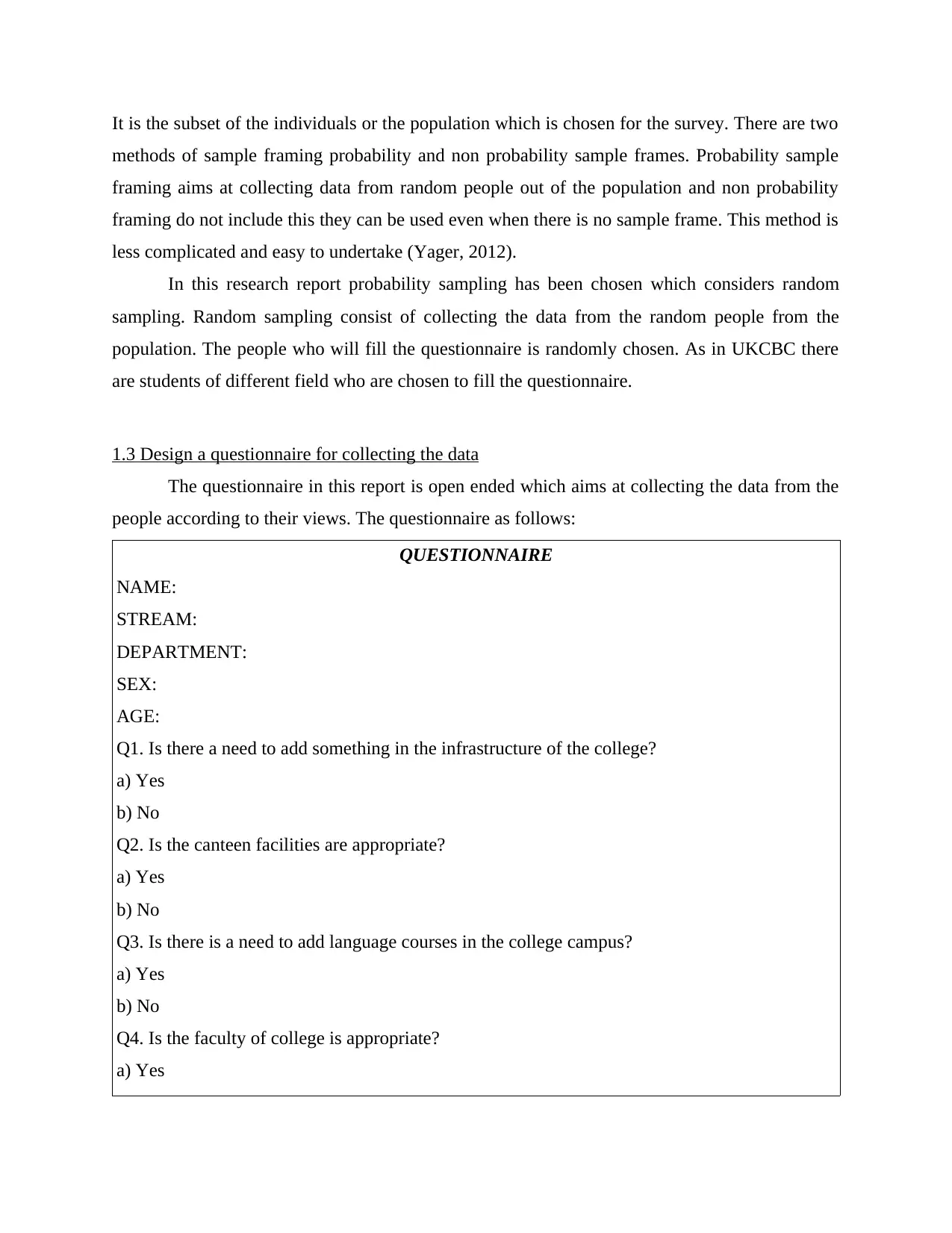
It is the subset of the individuals or the population which is chosen for the survey. There are two
methods of sample framing probability and non probability sample frames. Probability sample
framing aims at collecting data from random people out of the population and non probability
framing do not include this they can be used even when there is no sample frame. This method is
less complicated and easy to undertake (Yager, 2012).
In this research report probability sampling has been chosen which considers random
sampling. Random sampling consist of collecting the data from the random people from the
population. The people who will fill the questionnaire is randomly chosen. As in UKCBC there
are students of different field who are chosen to fill the questionnaire.
1.3 Design a questionnaire for collecting the data
The questionnaire in this report is open ended which aims at collecting the data from the
people according to their views. The questionnaire as follows:
QUESTIONNAIRE
NAME:
STREAM:
DEPARTMENT:
SEX:
AGE:
Q1. Is there a need to add something in the infrastructure of the college?
a) Yes
b) No
Q2. Is the canteen facilities are appropriate?
a) Yes
b) No
Q3. Is there is a need to add language courses in the college campus?
a) Yes
b) No
Q4. Is the faculty of college is appropriate?
a) Yes
methods of sample framing probability and non probability sample frames. Probability sample
framing aims at collecting data from random people out of the population and non probability
framing do not include this they can be used even when there is no sample frame. This method is
less complicated and easy to undertake (Yager, 2012).
In this research report probability sampling has been chosen which considers random
sampling. Random sampling consist of collecting the data from the random people from the
population. The people who will fill the questionnaire is randomly chosen. As in UKCBC there
are students of different field who are chosen to fill the questionnaire.
1.3 Design a questionnaire for collecting the data
The questionnaire in this report is open ended which aims at collecting the data from the
people according to their views. The questionnaire as follows:
QUESTIONNAIRE
NAME:
STREAM:
DEPARTMENT:
SEX:
AGE:
Q1. Is there a need to add something in the infrastructure of the college?
a) Yes
b) No
Q2. Is the canteen facilities are appropriate?
a) Yes
b) No
Q3. Is there is a need to add language courses in the college campus?
a) Yes
b) No
Q4. Is the faculty of college is appropriate?
a) Yes
⊘ This is a preview!⊘
Do you want full access?
Subscribe today to unlock all pages.

Trusted by 1+ million students worldwide
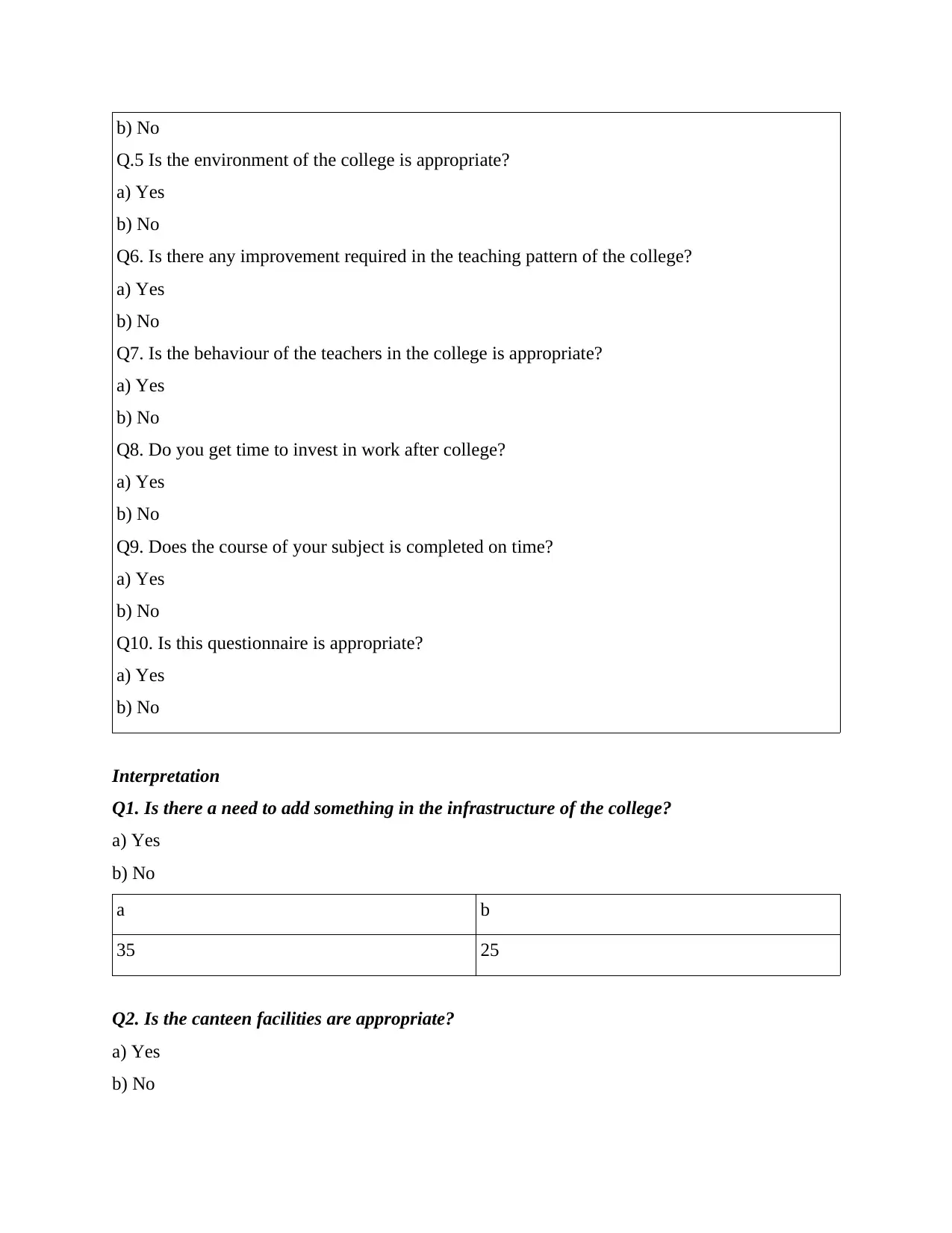
b) No
Q.5 Is the environment of the college is appropriate?
a) Yes
b) No
Q6. Is there any improvement required in the teaching pattern of the college?
a) Yes
b) No
Q7. Is the behaviour of the teachers in the college is appropriate?
a) Yes
b) No
Q8. Do you get time to invest in work after college?
a) Yes
b) No
Q9. Does the course of your subject is completed on time?
a) Yes
b) No
Q10. Is this questionnaire is appropriate?
a) Yes
b) No
Interpretation
Q1. Is there a need to add something in the infrastructure of the college?
a) Yes
b) No
a b
35 25
Q2. Is the canteen facilities are appropriate?
a) Yes
b) No
Q.5 Is the environment of the college is appropriate?
a) Yes
b) No
Q6. Is there any improvement required in the teaching pattern of the college?
a) Yes
b) No
Q7. Is the behaviour of the teachers in the college is appropriate?
a) Yes
b) No
Q8. Do you get time to invest in work after college?
a) Yes
b) No
Q9. Does the course of your subject is completed on time?
a) Yes
b) No
Q10. Is this questionnaire is appropriate?
a) Yes
b) No
Interpretation
Q1. Is there a need to add something in the infrastructure of the college?
a) Yes
b) No
a b
35 25
Q2. Is the canteen facilities are appropriate?
a) Yes
b) No
Paraphrase This Document
Need a fresh take? Get an instant paraphrase of this document with our AI Paraphraser
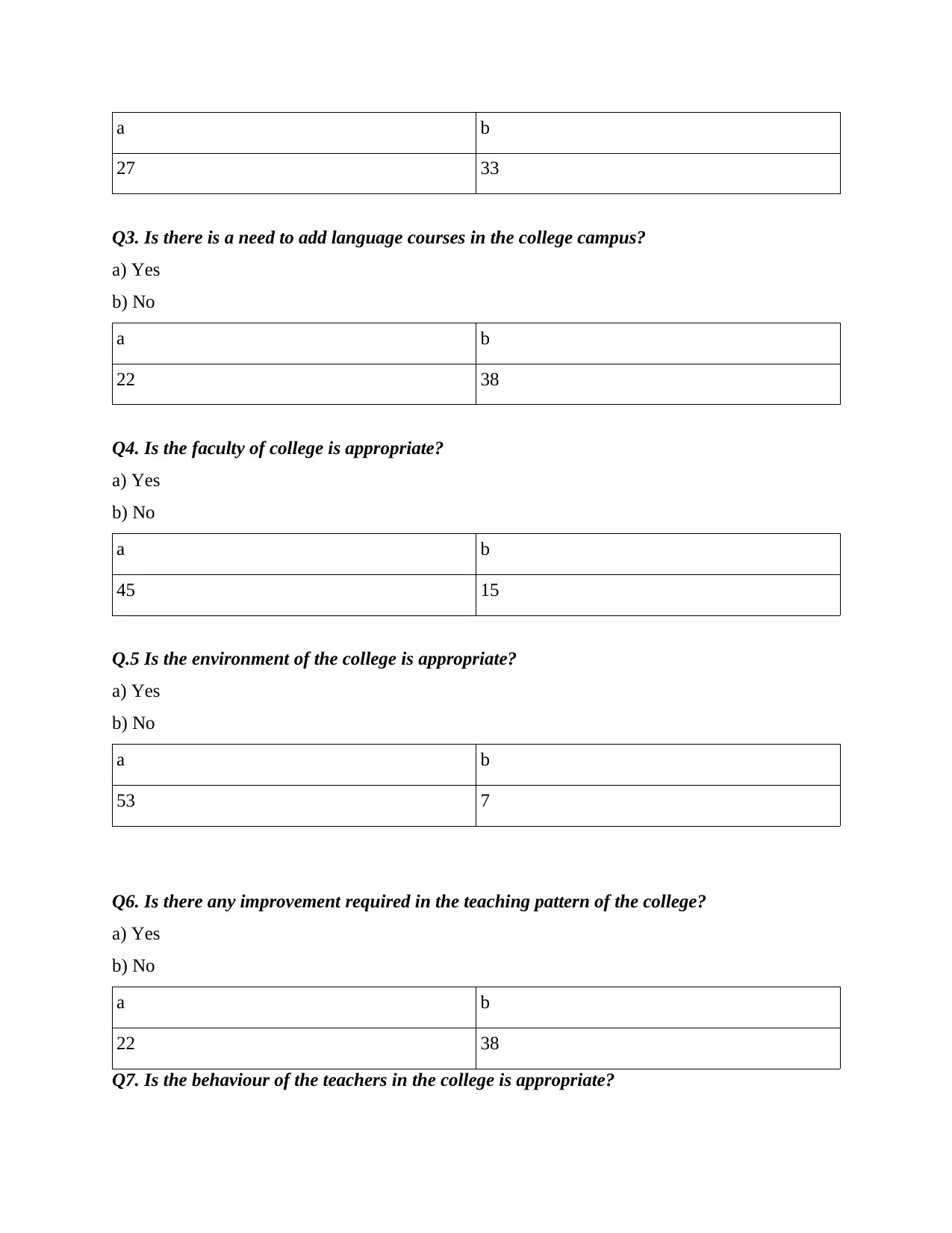
a b
27 33
Q3. Is there is a need to add language courses in the college campus?
a) Yes
b) No
a b
22 38
Q4. Is the faculty of college is appropriate?
a) Yes
b) No
a b
45 15
Q.5 Is the environment of the college is appropriate?
a) Yes
b) No
a b
53 7
Q6. Is there any improvement required in the teaching pattern of the college?
a) Yes
b) No
a b
22 38
Q7. Is the behaviour of the teachers in the college is appropriate?
27 33
Q3. Is there is a need to add language courses in the college campus?
a) Yes
b) No
a b
22 38
Q4. Is the faculty of college is appropriate?
a) Yes
b) No
a b
45 15
Q.5 Is the environment of the college is appropriate?
a) Yes
b) No
a b
53 7
Q6. Is there any improvement required in the teaching pattern of the college?
a) Yes
b) No
a b
22 38
Q7. Is the behaviour of the teachers in the college is appropriate?
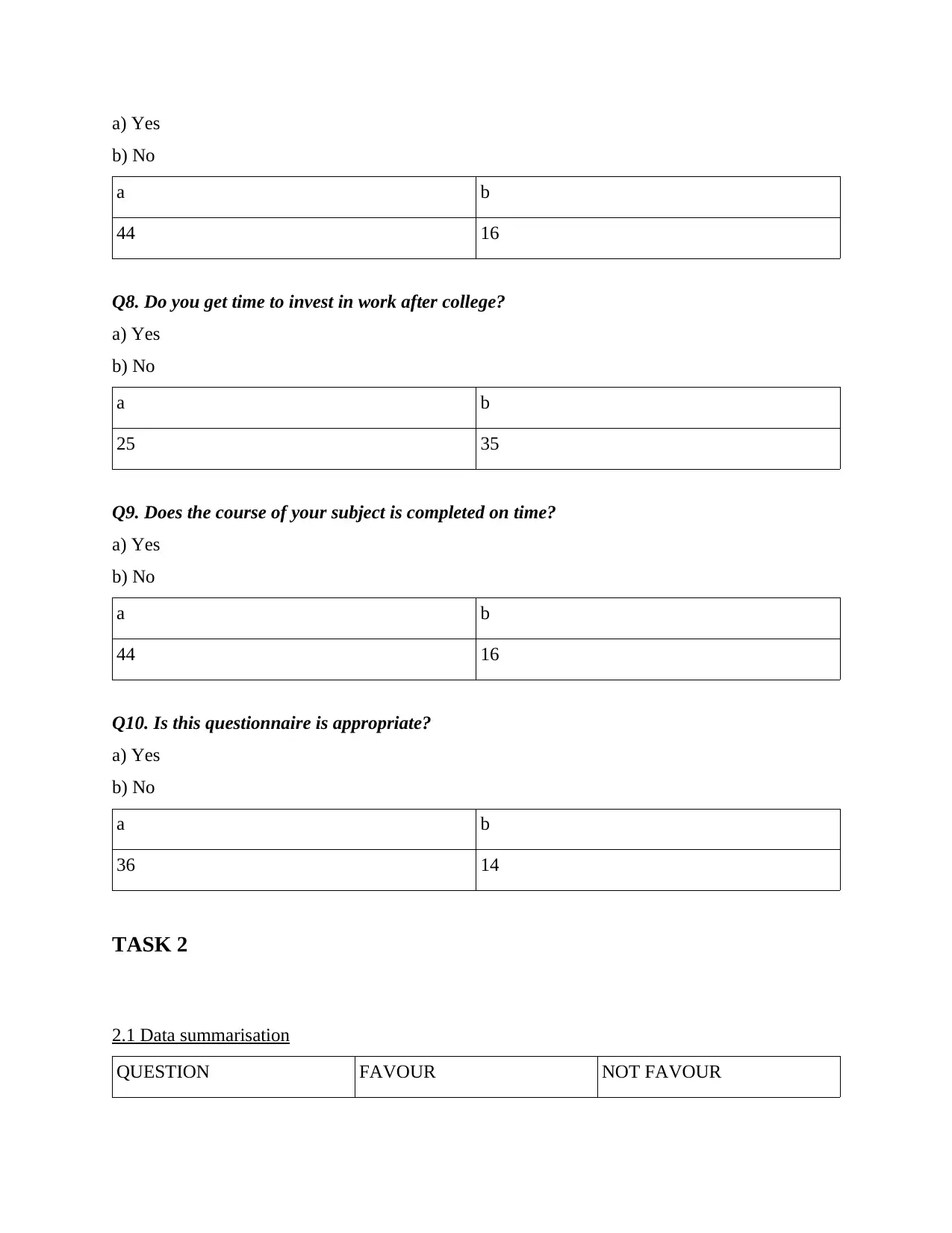
a) Yes
b) No
a b
44 16
Q8. Do you get time to invest in work after college?
a) Yes
b) No
a b
25 35
Q9. Does the course of your subject is completed on time?
a) Yes
b) No
a b
44 16
Q10. Is this questionnaire is appropriate?
a) Yes
b) No
a b
36 14
TASK 2
2.1 Data summarisation
QUESTION FAVOUR NOT FAVOUR
b) No
a b
44 16
Q8. Do you get time to invest in work after college?
a) Yes
b) No
a b
25 35
Q9. Does the course of your subject is completed on time?
a) Yes
b) No
a b
44 16
Q10. Is this questionnaire is appropriate?
a) Yes
b) No
a b
36 14
TASK 2
2.1 Data summarisation
QUESTION FAVOUR NOT FAVOUR
⊘ This is a preview!⊘
Do you want full access?
Subscribe today to unlock all pages.

Trusted by 1+ million students worldwide
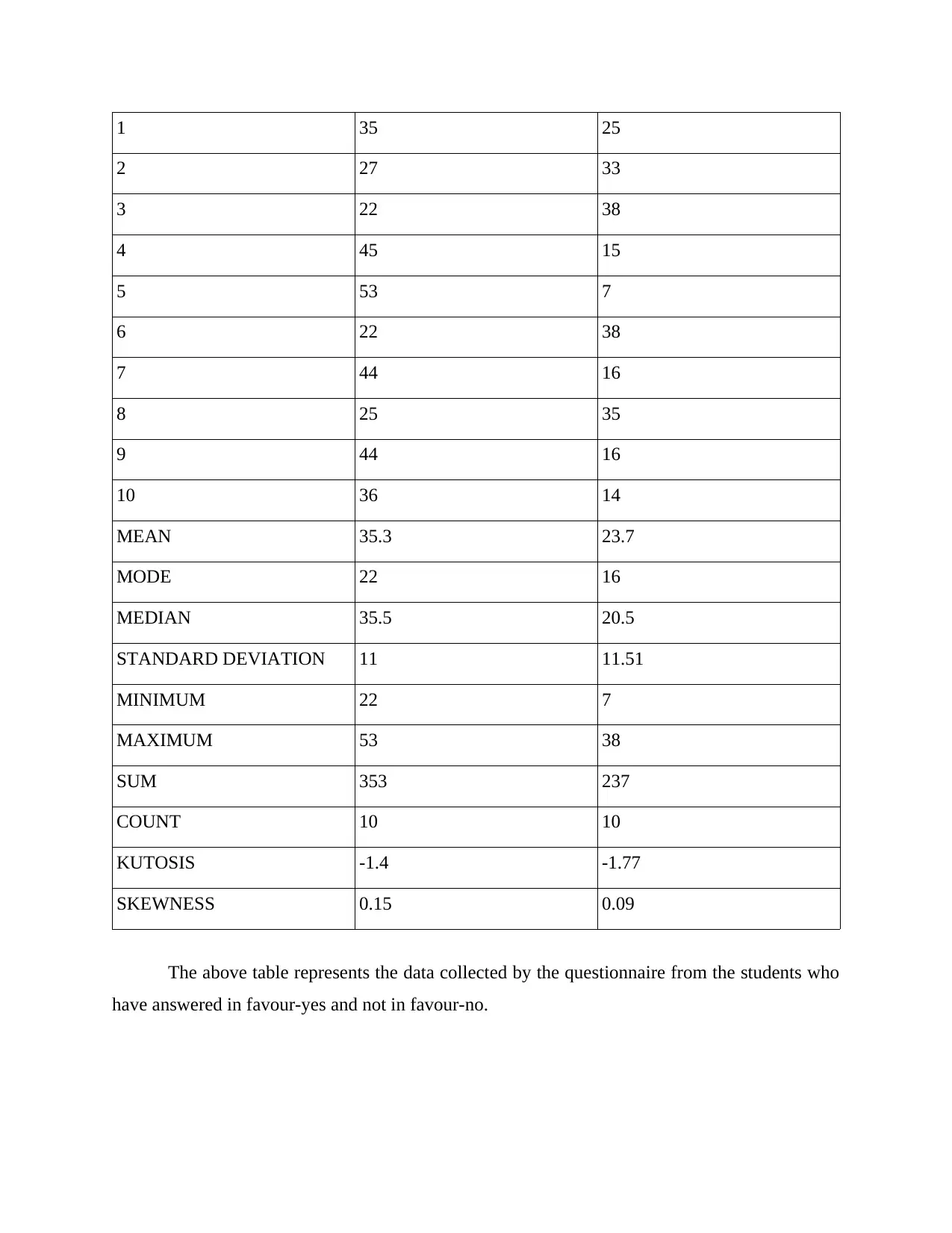
1 35 25
2 27 33
3 22 38
4 45 15
5 53 7
6 22 38
7 44 16
8 25 35
9 44 16
10 36 14
MEAN 35.3 23.7
MODE 22 16
MEDIAN 35.5 20.5
STANDARD DEVIATION 11 11.51
MINIMUM 22 7
MAXIMUM 53 38
SUM 353 237
COUNT 10 10
KUTOSIS -1.4 -1.77
SKEWNESS 0.15 0.09
The above table represents the data collected by the questionnaire from the students who
have answered in favour-yes and not in favour-no.
2 27 33
3 22 38
4 45 15
5 53 7
6 22 38
7 44 16
8 25 35
9 44 16
10 36 14
MEAN 35.3 23.7
MODE 22 16
MEDIAN 35.5 20.5
STANDARD DEVIATION 11 11.51
MINIMUM 22 7
MAXIMUM 53 38
SUM 353 237
COUNT 10 10
KUTOSIS -1.4 -1.77
SKEWNESS 0.15 0.09
The above table represents the data collected by the questionnaire from the students who
have answered in favour-yes and not in favour-no.
Paraphrase This Document
Need a fresh take? Get an instant paraphrase of this document with our AI Paraphraser
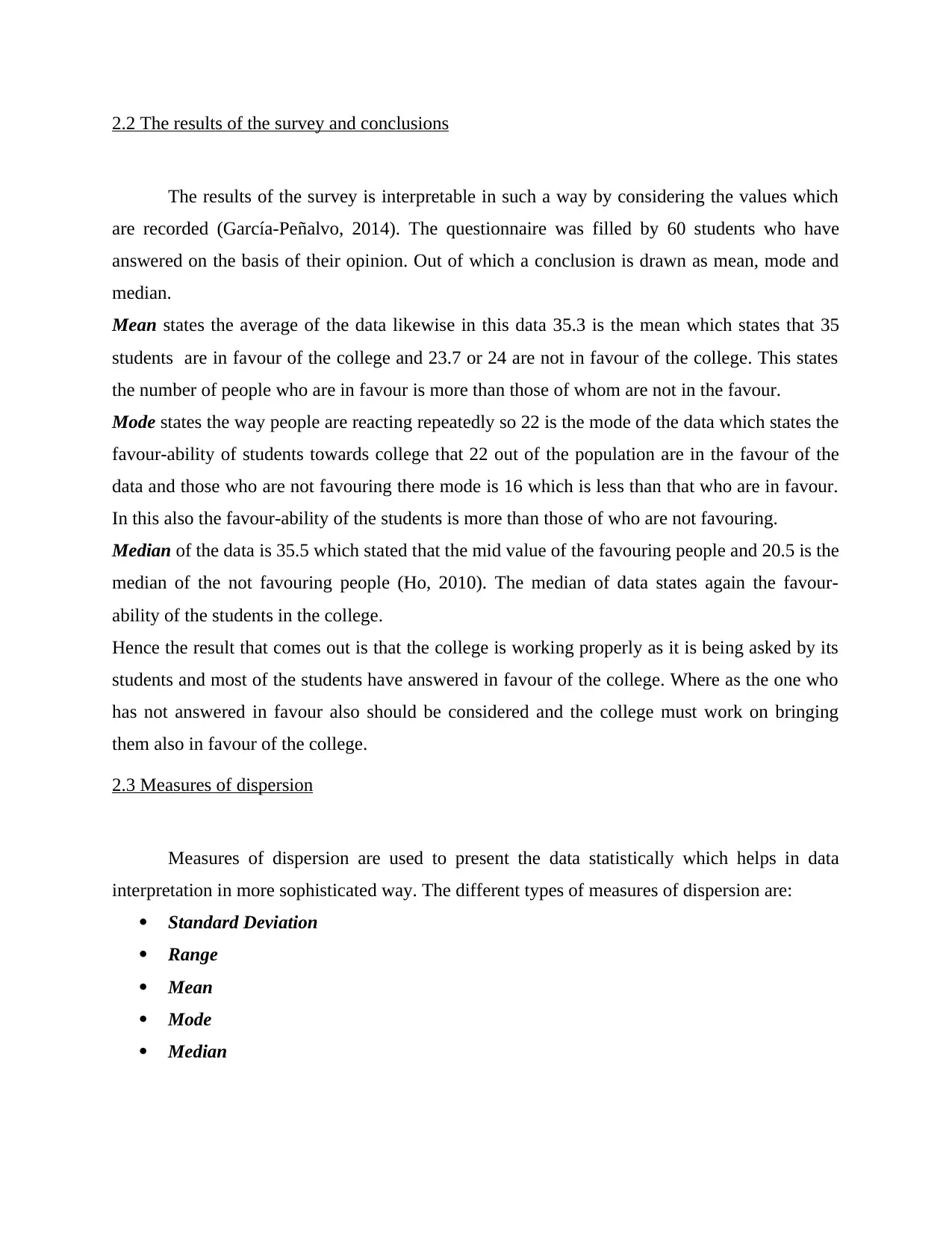
2.2 The results of the survey and conclusions
The results of the survey is interpretable in such a way by considering the values which
are recorded (García-Peñalvo, 2014). The questionnaire was filled by 60 students who have
answered on the basis of their opinion. Out of which a conclusion is drawn as mean, mode and
median.
Mean states the average of the data likewise in this data 35.3 is the mean which states that 35
students are in favour of the college and 23.7 or 24 are not in favour of the college. This states
the number of people who are in favour is more than those of whom are not in the favour.
Mode states the way people are reacting repeatedly so 22 is the mode of the data which states the
favour-ability of students towards college that 22 out of the population are in the favour of the
data and those who are not favouring there mode is 16 which is less than that who are in favour.
In this also the favour-ability of the students is more than those of who are not favouring.
Median of the data is 35.5 which stated that the mid value of the favouring people and 20.5 is the
median of the not favouring people (Ho, 2010). The median of data states again the favour-
ability of the students in the college.
Hence the result that comes out is that the college is working properly as it is being asked by its
students and most of the students have answered in favour of the college. Where as the one who
has not answered in favour also should be considered and the college must work on bringing
them also in favour of the college.
2.3 Measures of dispersion
Measures of dispersion are used to present the data statistically which helps in data
interpretation in more sophisticated way. The different types of measures of dispersion are:
Standard Deviation
Range
Mean
Mode
Median
The results of the survey is interpretable in such a way by considering the values which
are recorded (García-Peñalvo, 2014). The questionnaire was filled by 60 students who have
answered on the basis of their opinion. Out of which a conclusion is drawn as mean, mode and
median.
Mean states the average of the data likewise in this data 35.3 is the mean which states that 35
students are in favour of the college and 23.7 or 24 are not in favour of the college. This states
the number of people who are in favour is more than those of whom are not in the favour.
Mode states the way people are reacting repeatedly so 22 is the mode of the data which states the
favour-ability of students towards college that 22 out of the population are in the favour of the
data and those who are not favouring there mode is 16 which is less than that who are in favour.
In this also the favour-ability of the students is more than those of who are not favouring.
Median of the data is 35.5 which stated that the mid value of the favouring people and 20.5 is the
median of the not favouring people (Ho, 2010). The median of data states again the favour-
ability of the students in the college.
Hence the result that comes out is that the college is working properly as it is being asked by its
students and most of the students have answered in favour of the college. Where as the one who
has not answered in favour also should be considered and the college must work on bringing
them also in favour of the college.
2.3 Measures of dispersion
Measures of dispersion are used to present the data statistically which helps in data
interpretation in more sophisticated way. The different types of measures of dispersion are:
Standard Deviation
Range
Mean
Mode
Median
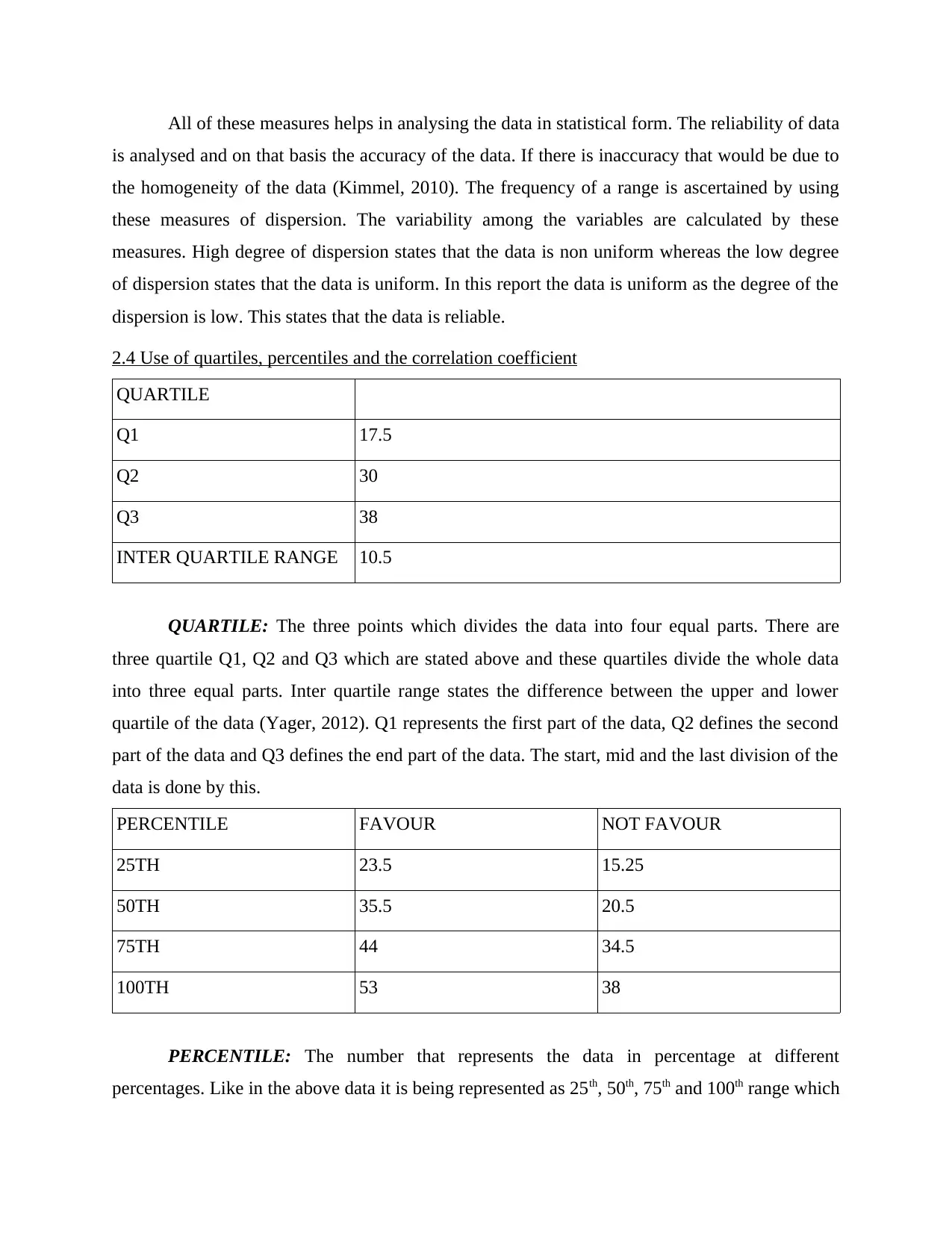
All of these measures helps in analysing the data in statistical form. The reliability of data
is analysed and on that basis the accuracy of the data. If there is inaccuracy that would be due to
the homogeneity of the data (Kimmel, 2010). The frequency of a range is ascertained by using
these measures of dispersion. The variability among the variables are calculated by these
measures. High degree of dispersion states that the data is non uniform whereas the low degree
of dispersion states that the data is uniform. In this report the data is uniform as the degree of the
dispersion is low. This states that the data is reliable.
2.4 Use of quartiles, percentiles and the correlation coefficient
QUARTILE
Q1 17.5
Q2 30
Q3 38
INTER QUARTILE RANGE 10.5
QUARTILE: The three points which divides the data into four equal parts. There are
three quartile Q1, Q2 and Q3 which are stated above and these quartiles divide the whole data
into three equal parts. Inter quartile range states the difference between the upper and lower
quartile of the data (Yager, 2012). Q1 represents the first part of the data, Q2 defines the second
part of the data and Q3 defines the end part of the data. The start, mid and the last division of the
data is done by this.
PERCENTILE FAVOUR NOT FAVOUR
25TH 23.5 15.25
50TH 35.5 20.5
75TH 44 34.5
100TH 53 38
PERCENTILE: The number that represents the data in percentage at different
percentages. Like in the above data it is being represented as 25th, 50th, 75th and 100th range which
is analysed and on that basis the accuracy of the data. If there is inaccuracy that would be due to
the homogeneity of the data (Kimmel, 2010). The frequency of a range is ascertained by using
these measures of dispersion. The variability among the variables are calculated by these
measures. High degree of dispersion states that the data is non uniform whereas the low degree
of dispersion states that the data is uniform. In this report the data is uniform as the degree of the
dispersion is low. This states that the data is reliable.
2.4 Use of quartiles, percentiles and the correlation coefficient
QUARTILE
Q1 17.5
Q2 30
Q3 38
INTER QUARTILE RANGE 10.5
QUARTILE: The three points which divides the data into four equal parts. There are
three quartile Q1, Q2 and Q3 which are stated above and these quartiles divide the whole data
into three equal parts. Inter quartile range states the difference between the upper and lower
quartile of the data (Yager, 2012). Q1 represents the first part of the data, Q2 defines the second
part of the data and Q3 defines the end part of the data. The start, mid and the last division of the
data is done by this.
PERCENTILE FAVOUR NOT FAVOUR
25TH 23.5 15.25
50TH 35.5 20.5
75TH 44 34.5
100TH 53 38
PERCENTILE: The number that represents the data in percentage at different
percentages. Like in the above data it is being represented as 25th, 50th, 75th and 100th range which
⊘ This is a preview!⊘
Do you want full access?
Subscribe today to unlock all pages.

Trusted by 1+ million students worldwide
1 out of 20
Related Documents
Your All-in-One AI-Powered Toolkit for Academic Success.
+13062052269
info@desklib.com
Available 24*7 on WhatsApp / Email
![[object Object]](/_next/static/media/star-bottom.7253800d.svg)
Unlock your academic potential
Copyright © 2020–2025 A2Z Services. All Rights Reserved. Developed and managed by ZUCOL.





